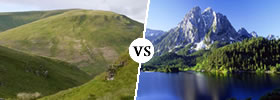Difference between Jaguar and Leopard
Key Difference: Jaguars are larger and stockier compared to leopards. Leopards are the smallest feline members of the Panthera genus. Jaguar has bigger and fewer rosettes, while leopards have smaller and more rosettes. Leopards also have small black dots inside their rosettes. Jaguars are found in the Americas, while leopards are found in Africa, India, Sri Lanka, Indochina, Malaysia, Indonesia, and China.
It is almost always difficult to tell a jaguar and a leopard apart at first glance as they are quite similar in appearance. However, these two majestic creatures have distinct differences. While they both belong to the same kingdom, family and genius; they are completely different species. They differ in terms of hunting style, shape, size, etc.

Jaguars are big felines that belong to the Panthera genus and Panthera onca speices. It is the third-largest feline, after the tiger and the lion and the only Panthera species that is found in the Americas. They can be found in the southern United States, Mexico and across much of the Central and South America. According to Online Etymology Dictionary, the word ‘jaguar’ comes to English language from one of the Tupi–Guarani languages, presumably the Amazonian trade language Tupinambá, via Portuguese ‘jaguar’. Due to loss of habitat and hunting, the species are dwindling and are now marked as Near Threatened on International Union for Conservation of Nature and Natural Resources’ (IUCN) Red List.
The jaguars are compact and well-muscled animals. They are large, muscular felines and have short strong legs. They are thick, powerful and stocky in build. They range from 1.2 to 1.95 m (3.9 to 6.4 ft) in length from nose to the tip of the tail. Their tails are the shortest of any big cat, at 45 to 75 cm (18 to 30 in) in length. The sizes of the cats vary. The females are 10-20% shorter than the males. They stand 63 to 76 cm (25 to 30 in) tall. Jaguars can weigh between 56 to 96 kg, with the largest weighing up to 160 kg. Jaguars are considered to have a striking resemblance to leopards because of their similar rosette shaped spots, but depending on its characteristics and behavior it is more closely related to tigers. The rosette shapes are larger and jaguars have fewer of them on their body. Each rosette also has small black spots in the middle. Jaguars also have dark solid lines on their tail. The jaguar’s short and stocky limb structure makes them more adept at climbing, crawling and swimming. They also have the second strongest jaw, following the spotted hyenas. Their jaw can break through the turtle shell and can also shatter animal skulls. The jaguar species is also known to face color morphism, where near black (melanistic) jaguars occur regularly. Albino or near white jaguars also occur but are rare.
Jaguars are carnivorous stalk-and-ambush predators. The stalk their pray slowly, trying to find a blind spot, before they either bite down on the prey’s neck and suffocate it or bite down on the skull and crack it. Jaguars can also kill many weak preys by smashing their paw into the skull, killing it instantly. Jaguars have twice the strength of lions and can drag up to 360 kg (800 lb) in weight. Once their prey is killed, jaguars drag it to a secluded spot before consuming it. Jaguars mate throughout the year, while reproduction is known to increase with the amount of food available. The females alone raise the cubs. Gestation period for a female lasts around 93–105 days and the cubs are born in a little of 2-4. The lifespan of a jaguar is estimated to be 12-15 years in the wild and up to 23 years in captivity.
 Leopards are the smallest feline members of the Panthera genus and belong to the P. pardus species. Originally, leopards were native to eastern and southern Asia and Africa and from Siberia to South Africa. However, due to hunting and loss of habitat they are now only primarily found in sub-Saharan Africa, with a small amount of population available in the Indian subcontinent, Sri Lanka, Indochina, Malaysia, Indonesia, and China. Due to their declining numbers, they rate as Near Threatened on the IUCN Red List.
Leopards are the smallest feline members of the Panthera genus and belong to the P. pardus species. Originally, leopards were native to eastern and southern Asia and Africa and from Siberia to South Africa. However, due to hunting and loss of habitat they are now only primarily found in sub-Saharan Africa, with a small amount of population available in the Indian subcontinent, Sri Lanka, Indochina, Malaysia, Indonesia, and China. Due to their declining numbers, they rate as Near Threatened on the IUCN Red List.
Leopards are predators that depend most on agility and stealth to hunt. Though they are the smallest of the Panthera genus, they are able to hunt large animals due to their powerful jaws and large skulls. Leopards are large and muscular, have short legs, a long body and a large skull. The length of the head and the body can range between 90 and 165 cm (35 and 65 in), while the tail reaches 60 to 110 cm (24 to 43 in) in length. They have a shoulder height of between 45 and 80 cm (18 and 31 in). Leopards vary in size depending on the animal and the sex of the animal. Males are generally 30% larger compared to the females and can weight around 30 to 91 kg (66 to 200 lb); while the females weight around 23 to 60 kg (51 to 130 lb). The coat and spots of leopards also vary depending on the region. Leopards in East Africa have small circular rosettes, while leopards in southern Africa and Asia have a squarer rosette. The color of the coat also ranges from yellow to cream and gray in some climates. Leopards have solid black spots on the face, limbs and underbelly. Melanism also occurs in leopards which are referred to as black panthers.
Leopards are also stalk-and-ambush predators and are opportunistic hunters. They prey on a large variety of animals. Similar to jaguars they silently stalk their prey trying to find a blind spot before jumping on their prey and biting down on their necks to immobilize them. Leopards are also known for hunting from trees by surprising their prey and pouncing on them from great heights. Leopards are the only natural predators of adult chimpanzees and gorillas. Leopards often carry their hunt to trees and other high places to keep them safe and away from other predators. Many leopards are known to hunt during the night. They have white moons under the eyes, which help reflect light better and allow them to see in the dark. Leopards can mate all year round; however in some places they mate mostly during January and February. Gestation lasts around 90-105 days and cubs are born in a litter of 2-4. The lifespan of leopards is estimated to be 15-17 years in the wild and up to 23 years in captivity.
|
|
Jaguar |
Leopards |
|
Kingdom |
Animalia |
Animalia |
|
Phylum |
Chordata |
Chordata |
|
Class |
Mammalia |
Mammalia |
|
Order |
Carnivora |
Carnivora |
|
Family |
Felidae |
Felidae |
|
Genus |
Panthera |
Panthera |
|
Species |
P. onca |
P. pardus |
|
Conservation status |
Near Threatened |
Near Threatened |
|
Habitat |
Southern United States and Mexico across much of Central America and south to Paraguay and northern Argentina. |
sub-Saharan Africa, Indian subcontinent, Sri Lanka, Indochina, Malaysia, Indonesia, and China |
|
Range |
Rainforests, open forests and terrains. Requires presence of water. |
Rain forests, Desert Terrains. |
|
Hunting Style |
Stalk-and-ambush predator. It also employees a unique method of biting through the temporal bones of the skull between the ears to kill the prey instantly. |
Stalks prey, Hunting from trees. |
|
Diet |
Their diet consists of approximately 87 species. It includes Caimans, deer, capybaras, tapirs, peccaries, dogs, foxes, frogs, mice, birds anacondas, cattle, horses, fish, sloths, monkeys, and turtles, etc. |
Elands, monkeys, rodents, reptiles, amphibians, insects, birds, foxes, jackals, martens, gazelles, impala, deer, etc. |
|
Build |
They are large muscular, have short strong legs. They are thick, powerful and stocky in build. |
Large muscular, short legs, long body and a large skull. |
|
Size |
The length, from the nose to the base of the tail can be between 1.2 to 1.95 m (3.9 to 6.4 ft). Their tails are the shortest of any big cat, at 45 to 75 cm (18 to 30 in) in length. The sizes of the cats vary. The females are 10-20% shorter than the males. They stand 63 to 76 cm (25 to 30 in) tall. |
4.25 to 6.25 ft; Tail, 3.5 to 4.5 ft |
|
Weight |
56 to 96 kg; Can go up to 160kg. |
30 to 80 kg; Can go up to 100kg. |
|
Reproduction |
Jaguars mate throughout the year, while reproduction is known to increase with the amount of food available. The females alone raise the cubs. Gestation period lasts around 93–105 days and the cubs are born in a little of 2-4. |
Leopards can mate all year round; however in some places they mate mostly during January and February. Gestation lasts around 90-105 days and cubs are born in a litter of 2-4. |
|
Young |
The young cubs are born blind and gain eyesight after two weeks. They wean at three months and start hunting around 6 months. They become independent around the age of 2 years. |
The cubs are born with their eyes closed. They have longer and thicker furs. The pelage is grayer with less defined spots. They start hunting around 3-4 months. |
|
Hybrids |
Jagupard and Leguar |
Leopon, Lipards; Jagupard, Leguar;and Pumapard. |
|
Spots |
Larger and fewer rosette shaped spots. |
Smaller and greater rosette shaped spots. |
|
Vocalization |
Roars; Growls; purs |
Roars; Growls |
|
Claws |
Retractable claws |
Fully retractable claws |
|
Distinguishing differences |
Larger and darker rosettes, thicker lines and small spots in the middle. Rounder heads, shorter and stockier limbs. Tiny black dots inside the rosettes. |
White moons under the eyes. |
|
Lifespan |
12–15 years in wild; 23 years in captivity. |
15-17 years in wild; 21 years in captivity. |
Image Courtesy: fanpop.com, quantumbiologist.wordpress.com









Add new comment